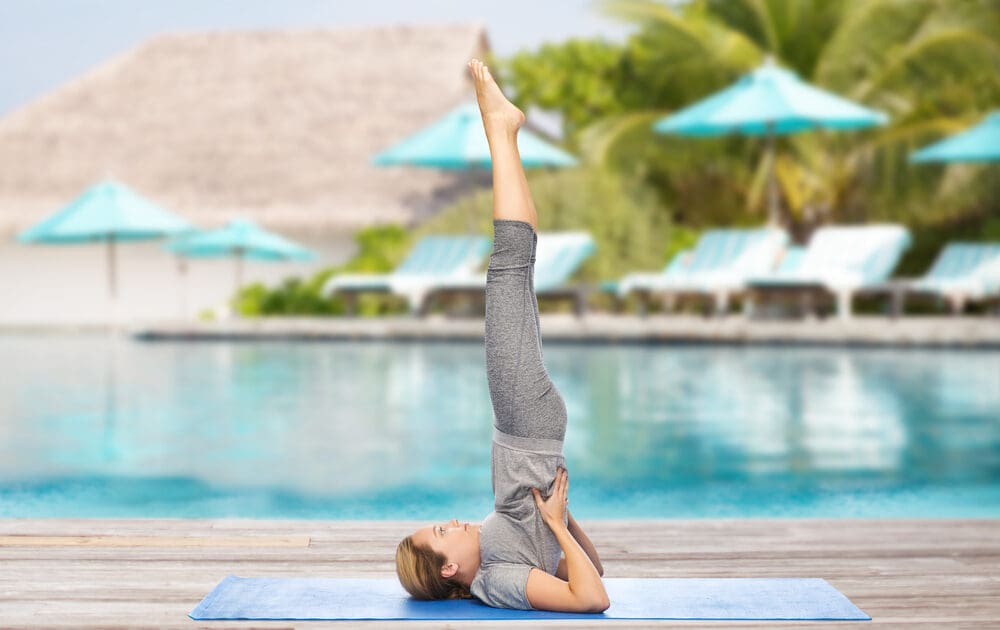6 Reasons to Practice This Forgotten Yoga Inversion Everyday

Shoulderstand, known as Salamba Sarvangasana in Sanskrit, is one of the main four yoga inversions known in Hatha yoga. It is known as the “queen” of the yoga postures, offering numerous health benefits that balance the body and the mind. But this valuable pose has largely been forgotten in a yoga culture where social media is riddled with images of fancy handstands and headstands. Below you’ll find 6 reasons why you should practice shoulderstand and start including this forgotten yoga inversion in your practice.
1. Strengthens the spine: When practiced in correct alignment, shoulderstand strengthens the spine, preparing it for more advanced inversion like headstand, and advanced backbends. In shoulderstand the torso, pelvis and legs should be held up by the shoulders and chest, and not by the neck. Seek guidance from a qualified instructor in order to learn the correct alignment for shoulderstand, or you may risk neck injury. It is recommended that shoulderstand be practiced consistently for at least 6 months before beginning a headstand practice.
2. Increases flexibility: Shoulderstand increases flexibility in the entire shoulder girdle, and opens the chest. It allows for the shoulders to move to the back body, re-correcting bad posture caused by sitting and hunching the shoulders. the pose increases flexibility along the whole line of the front body, and therefore also increases strength and muscle tone in the back body.
3. Improves circulation and respiration: Since shoulderstand is an inversion, it naturally let’s blood flow from the feet back toward the heart, which doesn’t happen when we are standing or sitting. When we upright again, fresh blood flows to the lower extremities, thus improving full body circulation (and also reducing varicose veins in the legs). This yoga inversion also reduces strain on the heart, and allows healthy blood to easily circulate around the neck and chest.
4. Balances the endocrine system: Salamba sarvangasana stimulates and regulates the thyroid gland, which is located just below the Adam’s apple and is responsible for secreting hormones that influence metabolism, growth and development, and body temperature. Many thyroid dysfunctions have evolved in our modern society, and shoulderstand can help to balance the gland and thus the functioning of the entire endocrine system.
5. Reduces stress: Practicing shoulderstand in the middle of the room without any props requires regular practice of the pose, but it can also be practiced with support in order to allow for longer durations in the pose. When held for several minutes, it can begin to reduce stress by soothing the parasympathetic nervous system, which regulates the autonomous functions of our body like blood pressure, and the work of our internal organs. When these are stabilized, our body releases stress and tension, therefore also relieving feelings of anger, anxiety and depression.
6. Aids in restful sleep: Because of all the benefits mentioned above, this pose is very effective in helping you sleep. When your physical and mental bodies are balanced and free of tension, they will be able to fully rest.
As with any yoga posture, especially inversion, seek guidance from a qualified yoga instructor when attempting to learn the correct way to practice shoulderstand. If you have medical complications, be sure to consult with your doctor before practicing this pose.
Related on Organic Authority:
This is How (and Why) a Yoga Practice Strengthens Your Nervous System and Brings Balance Back to Your Body
5 Restorative Yoga Poses to Strengthen the Nervous System
5 Tips for Starting (and Maintaining) a Personal Yoga Practice at Home
Shoulderstand image via Shutterstock

